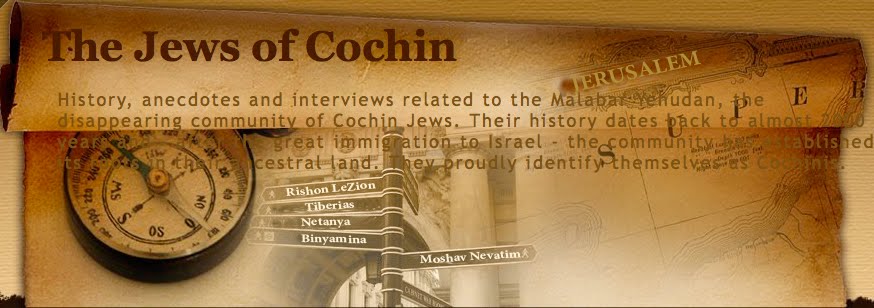By Bala Menon
The priceless copper plates of the Cochin Jews was a major topic of discussion at the Kochi-Muziris Biennale. (The Biennale ran from December 12, 2012 to March 13, 2013 with a series of live performances, art shows, lectures, films and cultural events throughout the three months.)
Jewish artist Joseph Semah made these plates the theme of an intriguing installation at the famed Aspinwall House (once a warehouse that stocked coconut, pepper and other valuable spices - commodities that the Jews of Cochin traded in for centuries.)
It was in 1000 CE that the legendary Kerala emperor Cheraman Perumal presented the set of plates to a Jewish leader named Joseph Rabban, granting him 72 proprietary rights equivalent to the Nairs who were then nobles of Malabar.
Emperor Kulashekhara Bhaskara Ravi Varman received Rabban in his palace at Mahodayapuram (near today's Kodungalloor) and made him the head of a powerful trade guild called Anjuvannam, conferring on him the special privileges "as long as the world, sun and moon endure."
The privileges included the use of aristocratic symbols like riding an elephant or palanquin, carrying weapons, lighting of special lamps, walking on a carpet, blowing trumpets and beating drums and the commercially important right to levy duties and tolls and exemption from taxes. The plates, written in the ancient Vattezhuthu script of Malayalam, were signed by seven governors of the provinces under the Chera emperor. The two rectangular plates are today preserved in the Holy Ark of the Paradesi Synagogue in Mattancherry. (Look out for a future blog on the copper plates.)
Semah's installation featured a 22-metre wooden table (representing the 22 letters in the Hebrew language), with 72 copper plates wedged in rows. Five thousand metres of thread (representing the circumference of the Old City of Jerusalem) were woven through holes (corresponding to the constellations above Jerusalem) and left snaking on the floor. The wall facing the installation displayed 72 drawings, each measuring 42 cm x 32 cms, done in Indian ink on tracing paper and sewn together with white thread into a sheet of music notes: the drawings made for a visual guide to the 72 privileges granted to Joseph Rabban. The whole installation dominated one entire warehouse on the second storey of the building.
Joseph Semah was born in Baghdad, but grew up in Tel Aviv and later moved to the Netherlands. The 64-year-old is a self-taught artist and "today runs the Makkom Foundation in Amsterdam and executes projects based on interdisciplinary research in the arts."
The installation was a major cultural event in Kochi, and the opening day saw "believers of the Islamic, Christian, Hindu, Buddhist, Jewish and secular traditions, standing back to back and reading from their holy texts." This was followed by an extempore dance by 72 children holding wine glasses. A recording of the performance (along with the glasses with a flame inside them) was later made part of the installation.
The Kochi-Muziris Biennale attracted more than 400,000 people. As the organizers said: "Art was taken out the galleries and onto streets and everyday places." In Kochi, it was bungalows and ancient warehouses that became art centres, hosting 80 artists from 24 countries." The exhibits were located at 14 places, including Jew Town in Mattancherry, Fort Kochi, Ernakulam and Kodungalloor, the site of the legendary port of Muziris.
References:
http://kochimuzirisbiennale.org
Malayala Manorama Online - http://www.manoramaonline.com
http://www.thehindu.com/news/cities/Kochi/kochi-gets-ready-for-a-dutch-treat/article4180760.ece
The priceless copper plates of the Cochin Jews was a major topic of discussion at the Kochi-Muziris Biennale. (The Biennale ran from December 12, 2012 to March 13, 2013 with a series of live performances, art shows, lectures, films and cultural events throughout the three months.)
 |
| One of the copper plates - in the Paradesi Synagogue in Mattancherry |
Jewish artist Joseph Semah made these plates the theme of an intriguing installation at the famed Aspinwall House (once a warehouse that stocked coconut, pepper and other valuable spices - commodities that the Jews of Cochin traded in for centuries.)
It was in 1000 CE that the legendary Kerala emperor Cheraman Perumal presented the set of plates to a Jewish leader named Joseph Rabban, granting him 72 proprietary rights equivalent to the Nairs who were then nobles of Malabar.
Emperor Kulashekhara Bhaskara Ravi Varman received Rabban in his palace at Mahodayapuram (near today's Kodungalloor) and made him the head of a powerful trade guild called Anjuvannam, conferring on him the special privileges "as long as the world, sun and moon endure."
 |
| Joseph Semah - with part of his installation at Aspinwall House. |
 |
| Semah's installation - the table with copper plates and threads running through 22 holes. |
Joseph Semah was born in Baghdad, but grew up in Tel Aviv and later moved to the Netherlands. The 64-year-old is a self-taught artist and "today runs the Makkom Foundation in Amsterdam and executes projects based on interdisciplinary research in the arts."
 |
| Art enthusiasts light up the 'privileges' which were then placed in wine glasses. |
The Kochi-Muziris Biennale attracted more than 400,000 people. As the organizers said: "Art was taken out the galleries and onto streets and everyday places." In Kochi, it was bungalows and ancient warehouses that became art centres, hosting 80 artists from 24 countries." The exhibits were located at 14 places, including Jew Town in Mattancherry, Fort Kochi, Ernakulam and Kodungalloor, the site of the legendary port of Muziris.
References:
http://kochimuzirisbiennale.org
Malayala Manorama Online - http://www.manoramaonline.com
http://www.thehindu.com/news/cities/Kochi/kochi-gets-ready-for-a-dutch-treat/article4180760.ece

